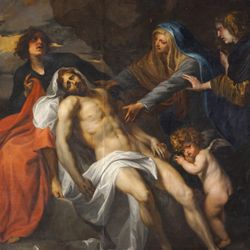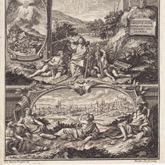Johann Daniel
Preißler
draftsman, copperplate engraver, portrait painter, historical painter
born Nürnberg, 17. Jan 1666
died Nürnberg, 13. Oct 1737
*17. 1. 1666 Nuremberg - † 13. buried 18. 10. 1737 Nuremberg,
Grave no. 1432 (formerly no. 1770 according to Pilz, 1984, p. 82) at Johannisfriedhof, epitaph not preserved.
Son of Daniel, painter. ∞ 17.1.1698 Anna Felicitas (* Kirchensittenbach - buried 9.9.1743), daughter of Johann Ulrich Riedner, deacon at St. Jakob, who was Preißler's cousin; eight sons, three daughters. Pupil of his stepfather Heinrich Popp, after his death in 1682 three-year apprenticeship with Johann Murrer. After his mother's death in 1685, he lived with his sister Anna Sibylla Heling. In 1688 he traveled to Italy in the company of the merchant Johann Lorenz Schweyer. There is evidence of stays in Venice, Bologna, Florence, Siena and from 6.4.1689 in Rome, where he initially stayed with Anton Negelein. In 1693 he temporarily took in the Nuremberg painter Johann Martin Schuster in his Roman lodgings. On May 28, 1696, he returned to Nuremberg in the entourage of the Margrave of Ansbach, Georg Friedrich the Younger, where he initially lived as a guest of the innkeeper Kaspar Zwanziger in the Haus zum Schwarzen Adler (formerly Breite Gasse 75). He belonged to the virtuosos or "3-guilder painters", to whom Johann Murrer and Johann Leonhard Kramer also belonged; according to the Rv. of 20.1.1701, these were released from certain duties of the craftsmen painters, but they had to pay 3 fl. annually into the painters' treasury. They were not exempt from the test piece, yet Preißler never produced one. Several times the painters' supervisors complained to the Rugamt. They achieved that Preißler was requested by Rv. of 20.4.1703 to produce the sample. At the same time he was forbidden to accept so many boys, "of whom he should have four", and under threat of punishment he was to pay contributions to the painters' treasury within 14 days. Johann Daniel Preißler did not comply with the order. By Rv. of December 15, 1704, he was appointed director of the painters' academy, an office he held until his death. Under his leadership, the academy underwent a tighter, school-like expansion, for which he issued a school regulation with eight paragraphs in 1704 with the approval of the council. At the suggestion of the Nuremberg envoy in Vienna, Heinrich Christoph Hochmann von Hohenau, a drawing school was added to the Academy of Painting in 1716, which Preißler also directed. For the lessons he translated from Italian the work "L'Anatomica dei Pittori del Signore Carlo Cesio, that is clear instruction and thorough idea of the anatomy of the painters". Hieronymus Böllmann engraved 16 full-page copper plates for it and published the work in 1706. Later, other drawing manuals and art-theoretical writings followed. Little known is Preißler's work "Orthographia", published around 1710, which shows the letters on twelve alphabet plates with rich floral accessories, often decorated with animals or putti.
His three-part drawing manual "Die durch Theorie erfundene Practic, oder Gründlich-verfasste Reguln ...", Nuremberg 1721-25, was extended by a fourth part by his son Johann Justin in 1757. It appeared in several editions and was still in use at the beginning of the 19th century. Preißler taught a large number of painters, among them were Johann Israel Dietzsch, Heinrich Haffner, Johann Georg Faber from Saxony-Meiningen (1712), the foundling Markus Tuscher (1722), Erasmus Simon Kongsperg "von Kongsperg aus Norwegen" (1724), George Desmarées (1725/27), Friedrich Bühl from Copenhagen (1726/27), the Swedish engraver Carl Gustav Lemoine (1727), Johann Daniel Meyer (1729), Georg Wilhelm Heiss, engraver from Augsburg (1734), Johann Leonhard Schneider (1734/35), and finally Christian Eißler from Copenhagen (1737), whom Preißler described as his cousin. Furthermore, the Augsburg engravers Hieronymus Sperling and Philipp Andreas Kilian worked with him for a time. In addition to training artists, Preißler influenced the foundations of academic art instruction over a long period of time, and his name is indispensable in the history of German art education. His artistic work mainly included portraits, ornamental engraving sequences with biblical and allegorical themes and engraving designs, furthermore illustrations for Endter Bibles. For the copper Bible published by Johann Jakob Scheuchzer/Johann Andreas Pfeffel in Augsburg in 1731, he "invented" the frames, a remarkable achievement, since no frame is repetitive, but each contains representations coordinated with the text.
Together with Johann Martin Schuster, he painted the ceiling paintings of the rebuilt Egidienkirche in 1711-18 (destroyed in World War II). In 1708 Preißler was appointed "Condukteur under the artillery". 1715-37 named. In 1733 he acquired the house Weinmarkt 12, which he sold again in 1736 for 1900 fl. He lived until his death in the Wasp's Nest on the Pegnitz, where the painters' academy was housed next door in the Katharinenkloster. Panzer recorded about 20 portraits of Nuremberg citizens as engraving models, his own portrait was engraved by his nephew Johann Georg Pintz after a model by Johann Martin Schuster. Of his children, four sons and one daughter became painters or engravers. His publishing house was continued by his widow.
Works: BEHRINGERSDORF, Lutheran parish church: altar leaf, 1718/19. LAUF/ Pegnitz, Lutheran parish church: altar leaf. For a list of his natural history works, writings and copper engravings, see Ludwig, 1998, pp. 365-367.
MuS: NÜRNBERG, GNM; -, MStN: paintings, drawings, copper engravings.
Lit.: ADB; Thieme-Becker; Doppelmayr, 1730; Will, GL III, p. 241 u. VII, p. 197f.; C. G. Müller, 1791, pp. 75, 133, 146; Mummenhoff, in: MVGN 10, 1893, pp. 271-278; Barock, 1962; KDM Lauf, 1966; Heffels, 1969; Jamnitzer, 1985, pp. 167-190; Augsburger Buchdruck, 1997, pp. 809, 830; Ludwig, 1998; Tacke, 1995 u. 2001, p. 540 u. Stammtafel 76; Stadtlexikon 2000.
Issued: 1942/3; 1954/3; 1955/4; 1980/9.
(quoted from the Nuremberg Künstlerlexikon, edited by Manfred H. Grieb)
Style: Baroque

